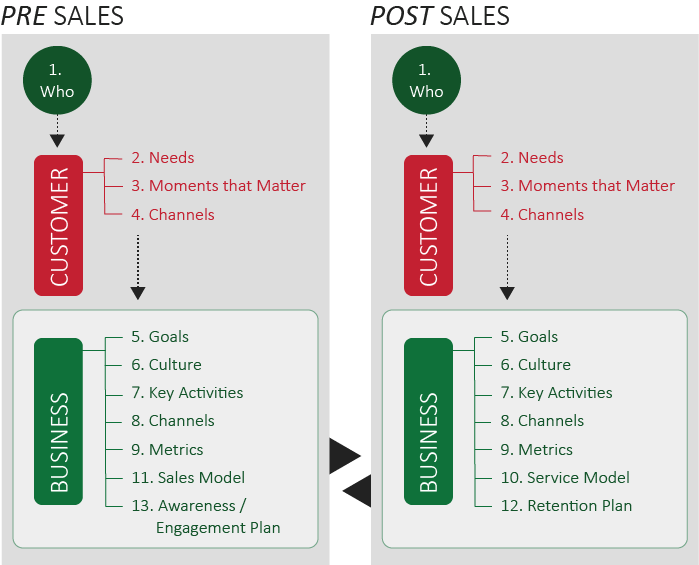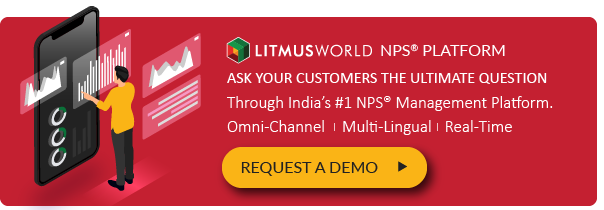The Ultimate Guide to the Net Promoter Score® (NPS): Proficient Level
Everything You Need To Know About NPS®! (Level Proficient)

8 minute read
The Ultimate Guide to the Net Promoter Score is designed for all (Beginner, Intermediate, Proficient and Expert) levels of NPS® practitioners. The aim of this guide is to consolidate everything you need to know about the Net Promoter Score/Net Promoter System on a single platform.
This guide encompasses everything from understanding to implementation to the success of NPS® initiatives. The guide is divided into 4 parts to make it easier for you to come back and continue reading from where you left-off. You are currently reading the ‘Level: Proficient’ guide to NPS®.
At the end of the 4-part guide is a quiz that you can take to test your knowledge and learnings from this guide. Happy upskilling!
Before we begin, here is a quick disclaimer about the Net Promoter Score/System®:
Net Promoter, Net Promoter Score and NPS® are registered trademarks of Bain & Company, Inc., Fred Reichheld and Satmetrix Systems, Inc. All titles, content, publisher names, trademarks, artwork, and associated imagery are trademarks and/or copyright material of their respective owners.
With that said, let’s begin our journey towards dramatic improvements!
In this section:
- Phase-wise implementation of NPS® measurement
- Cheat sheet to CX management using NPS®
- Convert detractors to promoters
- Improve response rates
- ROI of CX implementation
Q11. What is the phase-wise implementation of NPS® measurement and how should I get started?

NPS® implementation and CX management initiatives can be divided into the following 4 phases:
Phase 1: Launch
The first steps to implementing a great CX programme is creating an environment to get your customers talking. This involves creating a solution design that encompasses key factors such as touchpoint mapping, channel identification and emphasizing on key trackable matrices.
The ‘Launch’ phase of CX ideally takes 10-12 weeks from ideation to implementation. The main idea of this stage is to get the basics in place and open the doors for your customers to communicate directly with you. The scale of implementation complexity, IT integration and Customer adoption is comparatively lower as compared to the other 3 phases.
Phase 2: Learn
Phase 2 moves beyond the initial implementation and testing. This involves expanding the scope of the CX initiatives to additional touchpoints. The ‘Learn’ phase includes moving beyond a single channel of communication to aid your customers’ comforts and deploying an omnichannel strategy
While a CEM acts as a standalone tool, it needs to be integrated with your existing CRM to ensure real-time actionability of your customers’ data. Contextualising conversations depends on the information available at hand which can be extracted through the CRM. The ‘Learn’ phase expands the scope of the CX initiative beyond a singular touchpoint and ensures excellence across multiple touchpoints through active implementation of the takeaways from Phase 1 and deploying them across the entire customer journey.
Phase 3: Consolidate
The ‘Consolidate’ stage helps in utilising the existing environment for impacting the bottom line figures and increasing the overall brand value of the company. Companies that run referral campaigns through their CX initiatives have seen a 27% additional increase in their bottom line figures as opposed to companies that didn’t.
Based on customer lifetime value and purchase behaviour, contextual campaigns can be run to increase engagement. To take agile engagements to the next level, the CEM solution can be integrated with the social channels to get feeds rights into the dashboard real-time. These feeds can then be assigned to internal stakeholders basis the emotion of the feed and actionability of the issue.
Most importantly, the ‘Consolidate’ stage involves evangelising CX and onus of the customers amongst internal stakeholders. It is undeniable that the employees have more insights about the customers than what the CEM can capture. An ‘always-on’ employee conversation platform can bring the organization closer to real customers’ emotions, insights and perceptions.
Phase 4: Branded CX
While varied intensities of each of these phases help in creating a unique world-class CX initiative, the end-goal, however, remains the same – Branded CX! Aligning the organizational values and placing CX at the core of every strategic decision, through external and internal promises eventually gives the organization a competitive edge.
This is the final stage of the CX initiative and is a perpetually ongoing process. Customer demographics change, so do their demands, perceptions and expectations. Creating a foolproof CX initiative is conceptually impossible. But, getting really close to perfection is possible.
Q12. These phases look fairly complex, is there a cheat sheet to CX management using NPS®?
There is no denial of the fact that CX is not a one-team project. Ownership of the customer flows across the organization and engaging your employees is one of the many initial steps that drive CX excellence. Imagine the kind of insights your front-line agents have! Your customers may shy away from giving you quality insights, your employees will always have tales to tell.
And most importantly, all decisions made in the organization should be made with a customer-first approach to enable a centralised view of operational data, thereby building a data culture. Here is a cheat sheet that encompasses the 13 stages of a CEM implementation using NPS®:

- Stage 1: Who is your customer?
- Stage 2: Identifying customer needs
- Stage 3: Moments that matter
- Stage 4: What channels do your customers use?
- Stage 5: Aligning business goals
- Stage 6: Re-culturing the organization
- Stage 7: Key activities and Initiatives
- Stage 8: Channels you prefer
- Stage 9: Metrics and KPIs
- Stage 10: Service Model
- Stage 11: Sales Model
- Stage 12: Retention Plan
- Stage 13: And finally, Awareness/Engagement Plan
Q13. How do I convert my detractors to promoters?

When was the last time you made a purchase online without reading the reviews? Don’t recall right? You’re not alone. Almost 78% of consumers read reviews online before making a purchase (Spiegel Research Center).
In order to take complete advantage of the power of reviews to boost your brand image, you must be invested and engaged in talking to your customers. Understand what your customers are saying about your products or services. Did they love your product? Thank them for their loyalty. Were they dissatisfied? Close-loop and understand what went wrong. But most of all, engage with them!
Responding to feedback is an important step to take towards fostering trust with your customers. A heartfelt, well-written response coming from an employee can humanise a brand much more than just a ‘Like’ or a ‘Share’. Customers leaving feedback on social media expect to hear back from you immediately and not a templated acknowledgement to wait for a representative to get in touch with them.
While time is of the essence, it is easy to scroll past the positives and only focus on damage control. Or one may even find it tempting to just thank the positives and push the negatives under the rug. However, you’ll soon realise that responding to feedback requires balance. You’ll want to select both positive and negative feedback to get maximum returns from your time investment.
While it is important to respond on time and to everyone possible, it is also important to assign reviews/feedback to the right person. Did your customers talk about how a bad product quality resulted in health hazards? Probably the product team needs to be kept in the loop to address this query on a one-to-one interaction basis. While if a customer is talking about the unavailability of a shirt size in one of the stores, the store manager or the SKU manager would be the right person to address the issue.
That being said, it’s important for businesses to leverage customer feedback, both good and bad, to build their brands and stand apart from the crowd. Here are 10 pro tips to handle negative customer feedback that will help you convert your ‘Detractors’ to ‘Promoters’:
- Pro-Tip #1: Don’t be aggressive and/or confrontational
- Pro-Tip #2: Only customers who care provide feedback of any kind
- Pro-Tip #3: Don’t delete, don’t hide, don’t ignore
- Pro-Tip #4: Listen, apologise, solve
- Pro-Tip #5: Look beyond the words
- Pro-Tip #6: Reviews are the best marketing
- Pro-Tip #7: Thank them already!
- Pro-Tip #8: Disaster management
- Pro-Tip #9: Provide a go-to channel for consumers to share feedback
- Pro-Tip #10: Follow-up
I have explained each of these tips in detail in The agile approach to converting Detractors to Promoters. Head over and come back soon. You do not want to miss what follows next!
Q14. How do I improve my response rates?
Response rates are important to monitor the efficacy and reliability of the survey. The higher the response rate, the greater the engagement of the organization with their consumers and better the insights from the survey. Completion of the survey also helps us to use the opportunity for contextual campaigns and offers. A high Response Rate is LitmusWorld’s distinct competitive advantage.
Ideally speaking, there are 10 stages in the ‘Conversation Journey’ with a customer where a drop-off can happen. Here is a list of 10 ways to reduce drop-offs and improve the response rates:
- It is always advised to request feedback when the experience is fresh and the customer is keen to voice his opinion.
- Lack of data quality standards results in a fewer number of people receiving the request, snowballing into lesser participation
- Right from the subject lines, the email body, personalisation within the email, a clear CTA, sender name, context and length within the email lead to drop-offs and lower engagement rates.
- Make your SMS crisp, the preview text should contain a hook and the sender name should represent your brand.
- Having no clear CTA or having too many CTAs can result in a drop off due to confusion amongst respondents.
- An average feedback questionnaire should be optimised to capture maximum information and should not take more than 30 seconds for the respondent to fill.
- Your customers are giving you their time and efforts to give you information about what you can do to improve your business and increase your revenue. The least you can do is incentivise them for taking their time out for you.
- While requesting feedback, you have your customers’ attention for a maximum of 30 seconds. Do not waste it in capturing the quantifiables. Rather use this opportunity to capture emotions.
- Spam filters are getting aggressive day-by-day. Two ways to check for spam – 1. Online spam-check tools help in analysing the contents of the email and 2. Sample audience base (probably internal teams) to check if the emails land in the spam or in their inbox.
- 77% of all emails and websites accessed today are done through mobile phones and non-optimisation of your content (messaging or landing page) can result in substantial drop-offs. Make sure your emails and webpages are responsive and mobile, tablet and desktop ready!
LitmusWorld is known for providing the highest response rates as per industry standards. Here’s our secret!
Q15. I am new to the NPS® measurement game. How do I show the ROI of the CX implementation to the management?
The importance of calculating your customer experience ROI cannot be overstated—how will you Measure, Act and Improve your customer experience efforts if you don’t know the return on your CX investments?
NPS® measurement is a part of the bigger picture – Customer Experience Transformation. A well-executed CX transformation programme can lead to two types of ROI; one that can be easily quantified and the other that is more qualitative in nature.
Some of the key qualitative benefits can be broadly comprehended from the Image below:

This article will help you drive the quantitative ROI of your CEM implementation.
Despite a plethora of qualitative benefits, Customer experience leaders often face hurdles in budgetary approval because customer experience ROI has not been forecasted or quantitatively expressed.
Calculating The Quantifiable ROI:
The final ROI of a CEM solution implementation is equal to the total inflow of funds (minus) the total outflow of funds.
Total Inflow Of Funds:
The total inflow of funds depends on 3 major pillars i.e. Additional revenue due to increased retention (after 1 year), Additional revenue from cross-selling & up-selling, and total savings from the reduction in calls to customer care.
Total Outflow Of Funds:
The total outflow essentially is the investment on which you want to calculate the ROI. This is the investment in technology and the associated costs of project success.
This article will help you Calculate the ROI down to the last penny
Now that you’ve successfully completed the ‘Level: Proficient’ guide, let’s move to the ‘Level: Expert’ guide to NPS®.



